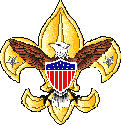| MERIT BADGES |
|
|
|
|
| Note: Eagle Required are in Italics |
"A"
American
Business
American Culture
American Heritage
American Labor
Animal Science
Archaeology
Archery
Architecture
Art
Astronomy
Athletics
Atomic Energy
Auto Mechanics
Aviation
"B"
Backpacking
Basketry
Bird Study
Bugling
"C"
Camping
Canoeing
Chemistry
Cinematography
Citizenship
Community*
Citizenship Nation*
Citizenship World*
Climbing
Coin Collecting
Collections
Communications*
Computers
Cooking
Crime Prevention
Cycling*
"D"
Dentistry
Disability Awareness
Dog Care
Drafting
"E"
Electricity
Electronics
Emergency
Preparedness**
Energy
Engineering
Entrepreneurship
Environmental
Science*
"F"
Family Life*
Farm Mechanics
Fingerprinting
Fire Safety
First Aid*
Fish & Wildlife Mgmt.
Fishing
Fly Fishing
Forestry
"G"
Gardening
Genealogy
Geology
Golf
Graphic Arts
"H"
Hiking
Home Repairs
Horsemanship
"I"
Indian Lore
Insect Studies
"J"
Journalism
"K"
"L"
Landscape Architecture
Law
Leatherwork
Lifesaving**
"M"
Mammal Study
Medicine
Metalwork
Model Design & Building
Motorboating
Music
"N"
Nature
"O"
Oceanography
Orienteering
"P"
Painting
Personal Fitness**
Personal Management*
Pets
Photography
Pioneering
Plant Science
Plumbing
Pottery
Public Health
Public Speaking
Pulp and Paper
"Q"
"R"
Radio
Railroading
Reading
Reptile & Amphibian Study
Rifle Shooting
Rowing
"S"
Safety
Salesmanship
Scholarship
Sculpture
Shotgun Shooting
Skating
Skiing
Small Boat Sailing
Soil & Water
Conservation
Space Exploration
Sports**
Stamp Collecting
Surveying
Swimming**
"T"
Textile
Theatre
Traffic Safety
Truck Transportation
"U"
"V"
Veterinary Medicine
"W"
Water Skiing
Weather
Whitewater
Wilderness Survival
Wood Carving
Woodwork
"X"
"Y"
"Z"
|
|
- Explain the nature and function of the soil. Tell about its texture, structure, need for water, air, organic matter, and the relationship of plants to the soil. Tell how the soil may be improved. Select one soil type from your area. Describe it in relation to the above.
- Describe how to prepare a seedbed for each of the crops in the options below. Submit a plan for planting an orchard crop. Describe the best type of site for such an orchard.
- Make and use a germination seed tester to test 50 seeds of four of the following plants: corn, cotton, alfalfa, soybeans, clover, wheat, rice, rye, barley. Determine percent of live seeds.
- Tell how to propagate plants by seeds, roots, cuttings, tubers, buds, and grafts.
- Tell about one important insect pest and one important disease that damage each of the following: corn, small grains, cotton, and fruit trees. Collect and name five weeds that damage crops in your locality. Tell how to control these without harming people, wildlife, or useful insects.
- On a map of the United States indicate the chief regions where the crops listed in the options are produced. Indicate a leading state in production of each crop. Tell how climate and location of these states makes them leaders.
- Tell about three career opportunities in crop production.
Complete ONE of the following options:
Corn Option
- Grow a plot of corn. Record seed variety or experimental code number.
- Have your plot inspected by your counselor. Tell about modern methods of commercial corn farming.
- Tell about the contributions corn makes to today's food supply.
Cotton Option
- Grow a plot of cotton.
- Have your plot inspected by your counselor. Tell about modern methods of commercial cotton farming.
- Tell about an insect that causes serious damage. Tell how it affects cotton production. Tell how it is controlled.
- Tell how cotton is processed from the field to the finished product.
Forage Crops Option
- Collect and mount for display three samples of each: perennial grasses, annual grasses, legumes, and broadleaf weeds. Label each grass and legume, indicating what use is made of it. Label each weed. Tell where each is most likely to be found.
- Explain how legumes can be used to enrich the soil. Tell how they may deplete it under certain conditions. Do the same for grasses.
- Describe five poisonous plants dangerous to livestock.
- Tell the different ways for using forage crops as feed for livestock.
Fruit and Nuts Option
- Plant five fruit or nut trees, grapevines, or berry plants.
- Take full care of fruit or nut trees, grapevines, or berry plants through one crop season.
- Prune a tree, vine, or bush properly. Explain why pruning is necessary.
- Demonstrate how a graft is made.
- Describe how one fruit, nut or berry crop is processed for use.
Small Grains Option
- Give production figures for the small-grain crops listed in the United States Statistical Report for the latest year available.
- Help in harvesting a crop of grain. Tell how to reduce harvesting losses.
- Visit a grain elevator, flour mill, cereal plant, feed or seed company. Talk with the operator. Take notes. Describe the processes used.
Oil Crops Option
- Grow a plot of soybeans.
- Have your plot inspected by your counselor.
- Tell about modern methods of soybean growing on a commercial scale.
- Tell of the contributions soybeans make to our food supply.
|
||||||
Last Update May 15, 2023

.jpg)

 Plant Science
Plant Science